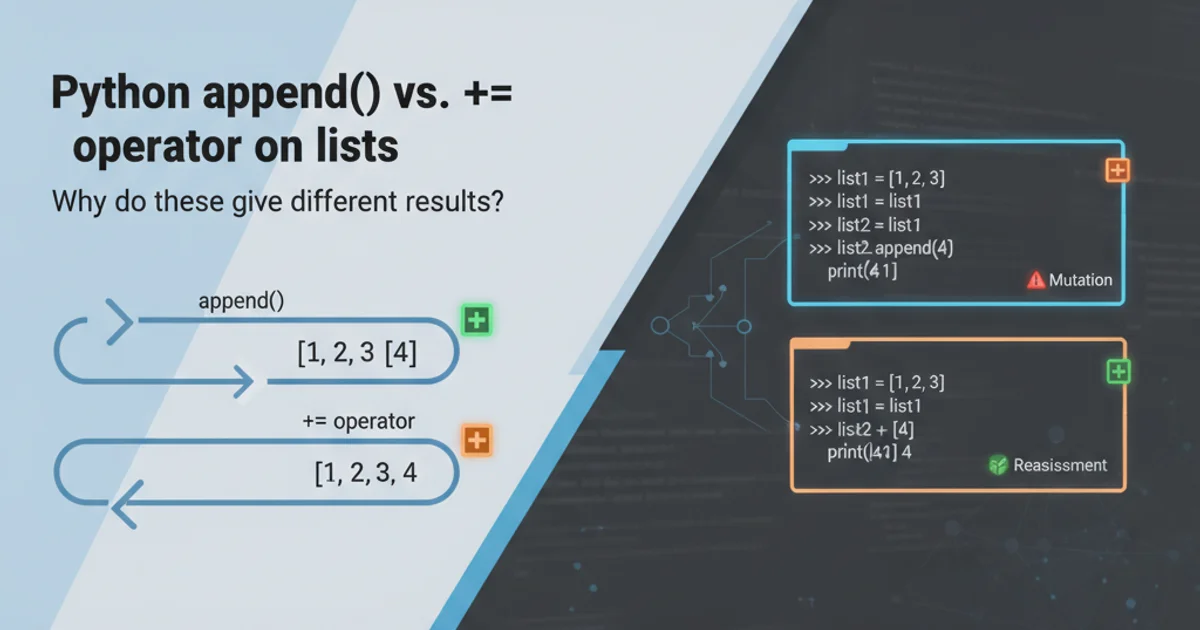Python append() vs. += operator on lists, why do these give different results?
Categories:
Python Lists: Understanding append() vs. += for List Modification

Explore the subtle yet critical differences between Python's list.append() method and the += operator when modifying lists, especially in the context of nested lists. Learn why they produce distinct results and when to use each.
Python offers several ways to modify lists, and two common approaches are using the append() method and the += operator. While they might seem similar at first glance, especially for simple list additions, their behavior diverges significantly when dealing with nested lists or when considering their underlying operations. Understanding these differences is crucial for writing correct and predictable Python code, preventing unexpected side effects, particularly in scenarios involving references and mutable objects.
The list.append() Method: Adding a Single Element
The append() method is a fundamental list operation designed to add a single element to the end of a list. It modifies the list in-place and always treats its argument as a single item, regardless of whether that item is another list, a tuple, or any other data structure. This means if you append() a list, the entire list you're appending becomes a single element within the original list, effectively creating a nested structure.
my_list = [1, 2, 3]
my_list.append(4)
print(my_list)
# Output: [1, 2, 3, 4]
my_list_nested = [1, 2]
other_list = [3, 4]
my_list_nested.append(other_list)
print(my_list_nested)
# Output: [1, 2, [3, 4]]
Demonstrating append() with a single element and a nested list.
flowchart TD
A[Original List: [1, 2]] --> B{append([3, 4])}
B --> C[Result: [1, 2, [3, 4]]]
C --"[3, 4] is a single element"--> D["Nested List Structure"]Visualizing the append() operation with a list as an element.
The += Operator (In-place Concatenation/Extension)
The += operator, when applied to lists, performs an in-place extension or concatenation. It's essentially syntactic sugar for list.extend(). Unlike append(), += expects an iterable as its right-hand operand and iterates over that iterable, adding each individual element from it to the end of the original list. This means if you use += with another list, the elements of that second list are added individually, flattening the structure rather than nesting it.
my_list = [1, 2, 3]
my_list += [4, 5]
print(my_list)
# Output: [1, 2, 3, 4, 5]
my_list_extended = [1, 2]
other_list = [3, 4]
my_list_extended += other_list
print(my_list_extended)
# Output: [1, 2, 3, 4]
Demonstrating += for list extension.
flowchart TD
A[Original List: [1, 2]] --> B{+= [3, 4]}
B --> C[Result: [1, 2, 3, 4]]
C --"[3, 4] elements are added individually"--> D["Flattened List Structure"]Visualizing the += operation for list extension.
Why the Different Results? Mutability and Object References
The core reason for the different behaviors lies in how Python handles objects and references, especially with mutable types like lists. Both append() and += modify the list in-place, meaning they don't create a new list object but rather alter the existing one. However, their interpretation of the 'item to add' is different:
append(item): Theitemis added as a single entity. Ifitemis a list, a reference to that list object is stored as an element in the original list.list += iterable: Theiterableis unpacked, and each of its elements is added individually to the original list. This is equivalent tolist.extend(iterable).
list.extend() behaves identically to += for lists. If you need to add multiple elements from an iterable to a list without nesting, extend() or += are your go-to options.Practical Implications and Best Practices
Choosing between append() and += depends entirely on your desired outcome:
- Use
append()when you want to add a single item, which might itself be a list, tuple, or dictionary, as a distinct element to your list. This is common when building lists of records or complex data structures. - Use
+=(orextend()) when you want to add all individual elements from another iterable (like another list, a tuple, or a string) to your current list, effectively flattening the structure. This is useful for combining lists or adding characters from a string individually.
# Scenario 1: Building a list of rows (nested lists)
matrix = []
row1 = [1, 2, 3]
matrix.append(row1)
row2 = [4, 5, 6]
matrix.append(row2)
print(matrix)
# Output: [[1, 2, 3], [4, 5, 6]]
# Scenario 2: Combining two lists into one flat list
list_a = [10, 20]
list_b = [30, 40]
list_a += list_b
print(list_a)
# Output: [10, 20, 30, 40]
Practical examples demonstrating appropriate use cases.
append() a list and then modify the original appended list, the changes will be reflected in the nested list because append() stores a reference, not a copy.